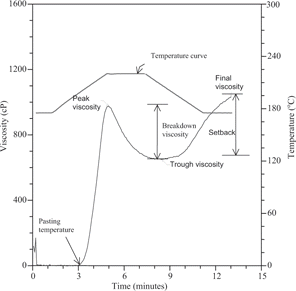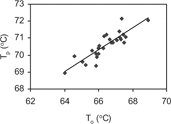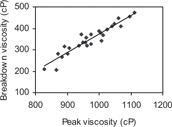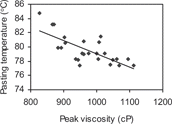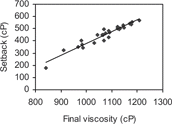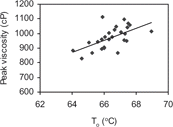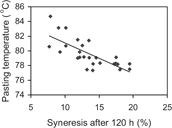Abstract
Starch was isolated from the corn lines obtained by crossing two different germ pools (MS and Tux pool) and evaluated for amylose content, swelling power, solubility, water binding capacity (WBC) and syneresis. The gelatinization (To, Tp, Tc, ΔHgel, PHI & R) and pasting (pasting temperature, peak viscosity, breakdown viscosity, final viscosity and set back) properties of starches were measured using Differential Scanning Calorimeter (DSC) and Rapid Visco Analyzer (RVA), respectively. The relationships between different properties were also determined using pearson correlation coefficients. Amylose content was negatively correlated to swelling power and WBC (p < 0.05). Several significant relationships were also observed between thermal and pasting properties of isolated starches. Transition temperatures (To, Tp & Tc) and PHI showed positive correlation with peak, trough and breakdown viscosity (p < 0.05). Syneresis of starches was positively correlated to amylose content (p < 0.05).
INTRODUCTION
Starch is the major polysaccharide in plants and is in the form of granules that exists naturally within the plant cells.[Citation1] Starch, the major carbohydrate of corn, makes up 72–73% of the kerne.[Citation2] Identification of native starch sources is required for desired functionality and unique properties.[Citation3] The physical properties of starch granules have been determined by analyzing the fine structure of the polysaccharide and the percent distribution of amylose and amylopectin.[Citation4] Starch exhibits unique viscosity behavior with change of temperature, concentration and shear rate.[Citation5]
Campbell et al.[Citation6] used Differential Scanning Calorimeter (DSC) to examine a set of normal corn dent hybrids and suggested that DSC had applications in breeding programs to screen germplasm for extreme values for developing breeding lines with unusual starch properties through crossing and recurrent selection. Li et al.[Citation7] characterized thermal properties of several exotic corn populations and suggested that thermal properties can be used as criteria for selection of desirable lines for breeding purposes to obtain starch with specific properties useful to industry.
Significant variability in the thermal properties of starch from corn genetic resources has been reported.[Citation6,Citation8] Seetharaman et al.[Citation9] reported several significant relationships between thermal and functional properties of starch. Kaur et al.[Citation10] reported several significant pearson's relationships between selected seed and starch properties of black gram. In our previous study, the changes in physicochemical and thermal properties of starches separated from corn produced by crossing corn lines of MS and Tux pool have been reported.[Citation11] These heterotic pools were synthesized in a very systematic way by introgressing germplasm on the basis of genetic diversity, pedigree diversity and heterosis. These pools serve as a reservoir for the derivation of lines for use in developing of hybrids for the commercial cultivation as a long-term programme. Tux × MS pool corn starches showed higher swelling power, solubility, onset temperature of gelatinization (T o), peak temperature of gelatinization (T p), conclusion temperature of gelatinization (T c), enthalpy of gelatinization (ΔH gel), peak height index (PHI) and syneresis than MS × Tux pool corn starches, while reverse was observed for amylose content. The present investigation was undertaken to establish relationships between physicochemical, thermal and pasting properties of starches separated from corn lines resulting from crossing MS and Tux germ pools. The study, also aims to get useful insight into the use of DSC and RVA as a tool for use in the plant breeding studies.
MATERIALS AND METHODS
Materials
A pair of heterotic pools namely MS pool and Tux pool has been used to develop hybrids for commercial cultivation. Twenty-six corn lines, obtained by crossing two different germ pools (MS and Tux pool) were procured from Regional Research Station, Punjab Agricultural University, Gurdaspur, India, from the 2001 harvest.
Starch Isolation
About 500 g of clean, sound and whole corn (10–20% moisture content) was added to 1.25 L of distilled water containing sodium hydrogen sulfite (0.1% SO2). The mixture was maintained at 50 ± 2° C for about 20–24 h with intermittent circulation of the liquid. After 24 h, the steep water was drained off and corn was ground in laboratory grinder. About 250 g of steeped corn were ground with 250 ml of distilled water. The ground slurry was screened through nylon cloth (100 mesh), and the residue was washed with distilled water until it was free of starch. The filtrate was passed successively over 200 and 325 mesh screens. The starch-protein slurry was then allowed to stand for 4–5 h. The supernatant was removed by suction and the settled starch layer was resuspended in distilled water and centrifuged in wide-mouthed cups at 2800 rpm for 5 min. The upper non-white layer containing glutinous material was scrapped off. The white layer was resuspended in distilled water and recentrifuged for 3–4 times. The starch was then collected and dried in an oven at 40° C for 12 h.
Physicochemical Properties of Starch
Amylose content of the isolated starch was determined by using the method of Williams et al.[Citation12] Swelling power and solubility were determined in triplicate, using the method of Leach et al.[Citation13] WBC of the starches from different corn varieties was determined using the method described by Yamazaki[Citation14] as modified by Medcalf and Gilles.[Citation15] A suspension of 5 g starch (dry weight) in 75 ml distilled water was agitated for 1 h and centrifuged (3,000 × g) for 10 min. The free water was removed from wet starch, drained for 10 min and wet starch was weighed.
Syneresis (%)
Starch suspension (2%, w/v) was heated at 85° C for 30 min in a temperature controlled water bath, followed by rapid cooling in an ice water bath to room temperature. The starch sample was stored for 72 and 120 h at 4° C. Syneresis was measured as % amount of water released after centrifugation at 3000 g for 15 min.
Thermal Properties
Thermal characteristics of isolated starches were studied by using a differential scanning calorimeter–821e (Mettler Toledo, Switzerland) equipped with a thermal analysis data station. Starch (3.5 mg, dry weight) was loaded into a 40 μl capacity aluminium pan (Mettler, ME-27331) and distilled water was added with the help of Hamilton micro syringe to achieve a starch-water suspension containing 70% water. Samples were hermetically sealed and allowed to stand for 1 h at room temperature before heating in the DSC. The DSC analyzer was calibrated using indium and an empty aluminium pan was used as reference. Sample pans were heated at a rate of 10° C/min from 20 to 100° C. Thermal transitions of starch samples were defined as T o (onset), T p (peak of gelatinization) and T c (conclusion), and Δ H gel was referred to enthalpy of gelatinization. These were calculated automatically. The gelatinization temperature range (R) was computed as 2( T p - T o ) as described by Krueger et al.[Citation16] Enthalpies were calclated on starch dry basis. The peak height index (PHI) was calculated by the ratio Δ H /( T p - T o) as described by Krueger et al.[Citation16]
Pasting Properties
Rheological properties of isolated corn starches were studied by using Rapid Visco Analyzer (Newport Scientific Pty Ltd., Warriewood NSW 2102, Australia). Viscosity profiles of starches from different corn varieties were recorded using starch suspensions (6%, w/w; 28 g total weight). The mixing speed of 960 rpm for 10 sec and then 160 rpm throughout the test was followed. The temperature-time conditions included a heating step from 50 to 95° C at 13° C/min (after an equilibration time of 1 min at 50° C at the start of RVA cycle), a holding phase at 95° C for 2.7 min, a cooling step from 95 to 50° C at 12° C/min and a holding phase at 50° C for 2 min. Each sample was analyzed in triplicate. The typical RVA pasting curve is shown in .
Statistical Analysis
The data reported in is the range for different parameters and is the average of triplicate observations. Pearson's correlation coefficients (r) for the relationships between all properties were calculated using Minitab Statistical Software version 13 (Minitab Inc, USA).
Table 1. Physicochemical, thermal, and pasting properties of starches from different corn lines.
RESULTS AND DISCUSSION
The correlation analysis of the physicochemical, thermal and pasting properties of starches provides the valuable insights information of the mechanisms contributing to the functional properties of the starches. Variability in physicochemical, thermal and pasting properties of starches from different corn lines was observed (). Sandhu et al.[Citation17] reported similar values for amylose content, swelling power, solubility and WBC in the range of 15.3–24.4%, 14.9–17.9 g/g, 12.5–20.3% and 96–107%, respectively for starches from different corn types. The swelling power and solubility provides evidence of magnitude of interaction between starch chains within the amorphous and crystalline domains.[Citation1] A significant negative correlation between amylose content and swelling power was observed (). Sandhya Rani and Bhattacharya[Citation18] also reported negative correlation of amylose content with swelling power. They stated that starch granules with low amylose content being less rigid, swell freely when heated. The starch granules with higher amylose content, on the other hand, being better reinforced and thus more rigid, probably swells less freely. WBC of the isolated starches was negatively correlated to amylose content (r = −0.343) and positively correlated to solubility (r = 0.458). Similar negative correlation between amylose content and WBC (r = −0.92) for starches from dent and flint corn has been reported earlier.[Citation19]
Table 2 Pearson correlation coefficients between various properties of starches from different corn lines.
Significant variability for DSC parameters was observed for starches isolated from different corn crosses (). Starch gelatinization has been described as the disruption of the molecular orders within the starch granule manifested in irreversible changes in properties such as granular swelling, loss of birefringence, starch solubilization and native crystallite melting.[Citation20] Seetharaman et al.[Citation9] reported values for T o, ΔH gel, PHI, and R in the ranges of 52.9–66.5° C, 10.2–13.3 J/g, 1.1–2.8 and 8.7–17.9, respectively for starches from 35 Argentinean corn landraces. The PHI provides a numerical value that describes the relative shape of the endotherm.[Citation21] The differences in DSC properties among the isolated corn starches could be attributed to the structural variations of the starch. According to White et al.[Citation8] genetic differences may account for variations in starch granule structure and molecular alignment, which in turn, may influence gelatinization behavior. Transition temperatures were observed to have positive correlation to each other (P < 0.01). T o was positively correlated to T p (). Similar positive correlations between the transition temperatures from starches from advanced generations of developmental lines developed from exotic inbred lines and exotic breeding crosses have been reported by Ji et al.[Citation22] T o and T p were positively correlated to PHI and negatively correlated to R (P < 0.01). A positive correlation between T p and ΔH gel was observed (). Positive correlations of T o with ΔH gel for OH43 inbred corn lines[Citation21] and of T p with ΔH gel (r = 0.50) for advanced generations of new corn lines has been reported earlier.[Citation22,Citation23] A significant negative correlation between PHI and R was observed (r = −0.892). Transition temperatures, ΔH gel and PHI were positively correlated to swelling power (P < 0.01) and negatively to solubility (P < 0.05). In the present study, the relationship between amylose content and gelatinization properties of starches measured using DSC (except for T c) was not significant. This may be attributed to the fact that the range of amylose content in corn lines was low (17.50–22.10%). Similar findings for nonsignificant relationship of amylose content with DSC parameters have been observed earlier.[Citation9]
Syneresis values for starches separated from different corn crosses also differed significantly. Syneresis ranged between 5.0–16.5% and 7.7–19.3% after 72 and 120 h of storage, respectively. Syneresis was positively correlated to amylose content () and swelling power (P < 0.05). Similar positive relationship of the amylose content and syneresis at 4° C (r = 1.00) for dent and flint corn, has been reported earlier by Kereliuk and Sosulski.[Citation19] Syneresis after 120 h of storage also showed positive correlation (P < 0.01) with transition temperatures.
The pasting properties of starches obtained from different corn crosses (measured using RVA) exhibited considerable variability. Ranges for the pasting properties of corn starches are reported in . Perera et al.[Citation24] reported similar values for these pasting properties. Various pasting properties were observed to significantly correlated to each other. Peak viscosity was positively correlated to trough (r = 0.419), breakdown (r = 0.946; ), final viscosity (r = 0.649), setback (0.531), and negatively correlated to pasting temperature (r = −0.722; ). Positive correlation of peak viscosity with setback, and breakdown has been reported.[Citation22,Citation23] Breakdown and final viscosity were observed to be highly positively, correlated to each other and setback (P < 0.01). shows the positive correlation between final viscosity and setback. Ji et al.[Citation22,Citation23] reported similar positive correlation of breakdown and setback (r = 0.74) for advanced generation of new corn lines. Pasting temperature was negatively correlated to breakdown, final viscosity and setback (P < 0.01). Several significant relationships were also observed between thermal and pasting properties. Transition temperatures and PHI showed positive correlation with peak, trough and breakdown viscosity. T o was positively correlated to peak viscosity (). Seetharaman et al.[Citation9] reported a highly positive correlation of T o with peak, trough and final viscosity (P < 0.001) for Argentinean corn starches measured using RVA. A significant positive correlation between viscosity at 95° C and T p, for the non mutant maize inbreds was reported earlier.[Citation6] Final viscosity and setback showed positive correlation with T c. R showed negative correlation with peak and breakdown. Syneresis value of the isolated starches correlated significantly with several pasting parameters. Syneresis showed negative correlation with pasting temperatures (; P < 0.01) and positive correlation with peak, breakdown, final viscosity and setback.
CONCLUSIONS
The correlation analysis of the physicochemical, thermal and pasting properties of starches provides the valuable insights information of the mechanisms contributing to the functional properties of the starches. Several significant correlations were observed between selected properties of starches from different corn lines. An interrelation between physico-chemical, thermal and pasting properties of corn starches was observed. Amylose content had significant impact on swelling power and syneresis tendency of starches. Transition temperatures and PHI showed positive correlation with pasting properties except for pasting temperature. DSC and RVA can be used as a valuable tool for their use in breeding programmes.
ACKNOWLEDGMENT
The financial support from CSIR, New Delhi in the form of Senior Research Fellowship to KSS is gratefully acknowledged.
Notes
aAM: Amylose content; SP: Swelling power; SOL: Solubility; WBC: Water binding capacity; To: Onset temperature; Tp: Peak temperature; Tc: Conclusion temperature; ΔHgel: Enthalpy of gelatinization; R: Range; PHI: Peak height index; SYN: Syneresis; PV: Peak viscosity; TV: Trough viscosity; BD: Breakdown viscosity; FV: Final viscosity; SB: Setback.
bCorrelation is significant at 0.05 level.
cCorrelation is significant at 0.01 level.
REFERENCES
- Singh , N. , Singh , J. , Kaur , L. , Sodhi , N.S. and Gill , B.S. 2003 . Morphological, thermal and rheological properties of starches from different botanical sources . Food Chem , 81 : 219 – 231 .
- Watson , S.A. 1987 . “ Structure and composition ” . In Corn: Chemistry and Technology , Edited by: Watson , S.A. and Ramstad , P.E. 53 – 82 . St Paul, MN : American Association of Cereal Chemists .
- Duxbury , D.D. 1989 . Modified starch functionalities-no chemicals or enzymes . Food Processing , 50 : 35 – 37 .
- Boyer , C.D. and Shannon , J.C. 1987 . “ Carbohydrates of the kernel ” . In Corn: Chemistry and Technology , Edited by: Watson , S.A. and Ramstad , P.E. 253 – 272 . St Paul, MN : American Association of Cereal Chemists .
- Nurul , I.M. , Azemi , B.M.N.M. and Manan , D.M.A. 1999 . Rheological behavior of sago (Metroxylon sagu) starch paste . Food Chem , 64 : 501 – 505 . [CROSSREF]
- Campbell , M.R. , Pollak , L.M. and White , P.J. 1995 . Genetic variation for starch thermal and functional properties among nonmutant maize inbreds . Cereal Chem , 72 : 281 – 286 .
- Li , J. , Berke , T.G. and Glover , D.V. 1994 . Variation for thermal starch properties of starch in tropical maize germplasm . Cereal Chem , 71 : 87 – 90 .
- White , P.J. , Abbas , I.R. , Pollak , L. and Johnson , L.J. 1990 . Intra- and interpopulation variability of thermal properties in maize starch . Cereal Chem , 67 : 70 – 73 .
- Seetharaman , K. , Tziotis , A. , Borras , F. , White , P.J. , Ferrer , M. and Robutti , J. 2001 . Thermal and functional characterization of starch from Argentinean corn . Cereal Chem , 78 : 379 – 386 .
- Kaur , M. , Singh , N. and Sandhu , K.S. 2004 . Relationships between selected properties of black gram seeds and their composition . Int. J. Food Prop. , 1 ( 3 ) : 1 – 12 .
- Sandhu , K.S. , Singh , N. and Malhi , N.S. 2005 . Physicochemical and thermal properties of starches separated from corn produced from crosses of two germ pools . Food Chem , 89 : 541 – 548 . [CROSSREF]
- Williams , P.C. , Kuzina , F.D. and Hlynka , I. 1970 . A rapid calorimetric procedure for estimating the amylose content of starches and flours . Cereal Chem , 47 : 411 – 420 .
- Leach , H.W. , McCowen , L.D. and Schoch , T.J. 1959 . Structure of the starch granule I. Swelling and solubility patterns of various starches . Cereal Chem , 36 : 534 – 544 .
- Yamazaki , W.T. 1953 . An alkaline water retention capacity test for the evaluation of cooking baking potentialities of soft winter wheat flours . Cereal Chem , 30 : 242 – 246 .
- Medcalf , D.G. and Gilles , K.A. 1965 . Wheat starches. I. Comparison of physicochemical properties . Cereal Chem , 42 : 558 – 568 .
- Krueger , B.R. , Knutson , C.A. , Inglett , G.E. and Walker , C.E. 1987 . A differential scanning calorimetry study on the effect of annealing on gelatinization behavior of corn starch . J Food Sci , 52 : 715 – 718 .
- Sandhu , K.S. , Singh , N. and Kaur , M. 2004 . Characteristics of the different corn types and their grain fractions: physicochemical, thermal, morphological, and rheological properties of starches . J Food Eng , 64 ( 1 ) : 119 – 127 . [CROSSREF]
- Sandhya Rani , M.R. and Bhattacharaya , K.R. 1989 . Rheology of rice-flour pastes: effect of variety, concentration, and temperature and time of cooking . J Texture Studies , 20 : 127 – 137 .
- Kereliuk , G.R. and Sosulski , F.W. 1996 . Comparison of starch from flint corn with that from dent corn and potato . Lebensm Wiss Technol , 29 : 349 – 356 . [CROSSREF]
- Atwell , W.A. , Hood , L. , Lineback , D. , Varriano-Marston , E. and Zohel , H. 1988 . The terminology and methodology associated with basic starch phenomena . Cereal Foods World , 33 : 306 – 311 .
- Wang , Y. , White , P. and Pollak , L. 1992 . Thermal and gelling properties of maize mutants from the OH43 inbred line . Cereal Chem , 69 : 328
- Ji , Y. , Seetharaman , K. , Wong , K. , Pollak , L.M. , Duvick , S. , Jane , J. and White , P.J. 2003 . Thermal and structural properties of unusual starches from developmental corn lines . Carbohydrate Poly , 51 : 439 – 450 . [CROSSREF]
- Ji , Y. , Wong , K. , Hasjim , J. , Pollak , L.M. , Duvick , S. , Jane , J. and White , P.J. 2003 . Structure and function of starch from advanced generations of new corn lines . Carbohydrate Poly , 54 : 305 – 319 . [CROSSREF]
- Perera , C. , Lu , Z. , Sell , J. and Jane , J. 2001 . Comparison of physicochemical properties and sugary-2 corn starch with normal and waxy cultivars . Cereal Chem , 78 : 249 – 256 .
